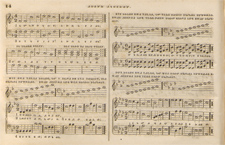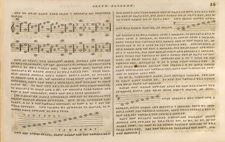
Vanished Worlds, Enduring People
The Written Word
Cherokee Singing Book. Printed for the American Board of Com-missioners for Foreign Missions. Boston: Alonzo P. Kenrich, 1846. [view first image] | [view second image]
Sequoyah (1760-1843) created the Cherokee syllabary as a cultural bulwark for his people, to lessen the influence of their white neighbors. A syllabary is a set of written characters, each one representing a syllable. By 1821, Sequoyah had reduced the number of symbols needed to produce whole Cherokee syllables to eighty-six characters, and the Cherokee Tribal Council formally adopted the system shortly after. Using the syllabary, the council started its own newspaper, The Cherokee Phoenix and Indian Advocate, in 1828. The syllabary proved easy to learn, promoting a high degree of literacy among the Cherokee throughout the 19th century in both North Carolina and Oklahoma. The first sixteen pages of this Singing Book contain instructions in music, while hymns in Cherokee comprise the rest.
